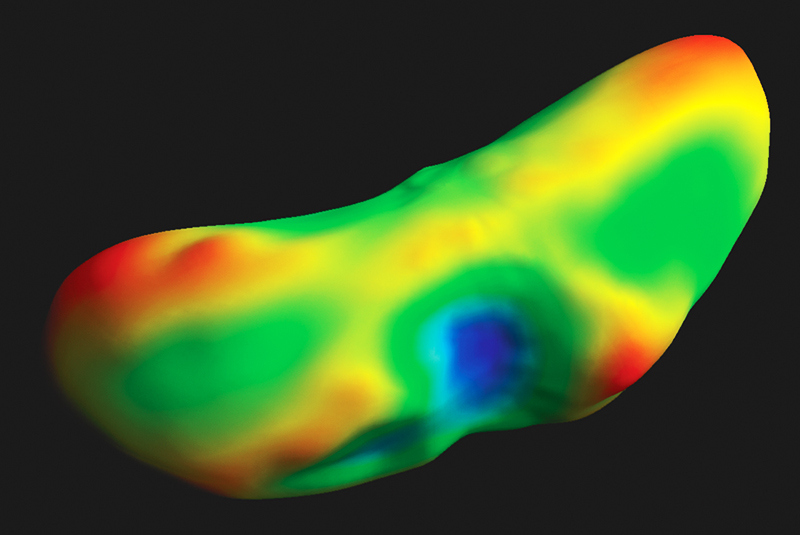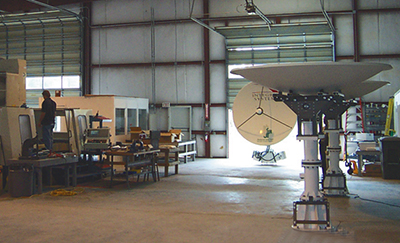
Satellite and Ground System Solutions at Your Fingertips
Originating Technology/ NASA Contribution
In the summer of 1998, the blockbuster action movie “Armageddon” captivated audiences with a thrilling doomsday plot about a meteor the size of Texas that was racing towards the Earth. Though the premise of the movie was purely fictional, the unfortunate reality is that near-Earth asteroids such as the one portrayed in the film do exist.
On December 23, 2004, NASA announced that an asteroid it anticipated to pass near the Earth on April 13, 2029, had been assigned the highest score to date on the universally used Torino Impact Hazard Scale. At first, the flyby distance for the asteroid, dubbed MN4, was uncertain and an Earth impact could not be ruled out. The odds of impact were initially believed to be 1 in 300, high enough to merit special monitoring by astronomers around the world, but were then escalated to 1 in 37 on December 27. NASA officials noted, however, that these odds should not be of public concern, since they were likely to change on a day-to-day basis as new data were received. The officials were correct in their assertion, as any chances of an impact with Earth in 2029 were completely ruled out later that same day.
Integral Systems, Inc., a leading provider of satellite ground systems and the first company to offer an integrated suite of commercial-off-the-shelf software products for satellite command and control, is helping NASA keep a careful watch for any close-encountering asteroids with its tracking technology. The company supported the first NASA Discovery mission, the Near Earth Asteroid Rendezvous (NEAR) program, back in 1996, and has expanded its business by building more ground systems for a greater variety of satellites than any other company in the world. (NASA has since launched seven more Discovery missions, with the eighth lifting off earlier this year.) The experience gained from the company’s participation in developing satellite command and control ground systems for the NEAR program has bolstered its flagship product line, the EPOCH Integrated Product Suite (IPS), first featured in Spinoff 1997, and led to the creation of its latest product, the Skylight Direct Broadcast Ground Terminal.
Partnership
In supporting the NEAR program, Integral Systems was selected by the Johns Hopkins University Applied Physics Laboratory—the manager of this NASA Discovery mission—in November 1996 to provide up to 15 Low-Earth Orbit Autonomous Ground Terminals (LEO-Ts) for NASA’s Goddard Space Flight Center. The LEO-Ts were designed to make it easier and less expensive for principal investigators to obtain telemetry, tracking, and control services for the NEAR mission and all other scientific endeavors managed by the Applied Physics Laboratory. Integral Systems’s work on this project was directly incorporated into its commercial offering, the EPOCH IPS. Additionally, Integral Systems’s continued work with Goddard has entitled it to adopt some of NASA’s latest direct readout scientific algorithms for its new Skylight product.
Product Outcome
Satellite operators spend billions of dollars ensuring that orbiting satellites do not come crashing down, and millions more just to send simple commands to them. Integral Systems’s EPOCH IPS presents a more efficient, economical alternative to costly command and monitoring practices, as an all-in-one orbital command and control system that can be operated right from a user’s desktop.
Now that’s managing space from the workspace.
According to the company, every single U.S. weather satellite operator and more than half of all global commercial satellite operators depend on EPOCH IPS to manage their satellites.
“We’ve become the de facto industry standard for satellite operations,” said Steve Chamberlain, Integral Systems’s chief executive officer. “We’ve got the only software products that come right out of the box and fly on any satellite from any manufacturer.”
Customers employing EPOCH IPS can go from controlling one spacecraft to another without ever leaving their desk to go to another computer. The company compares the comprehensive EPOCH technology to a large, universal remote control; by simply pointing and clicking at any controllable commercial satellite whose information is stored in a computer system, EPOCH IPS can fly it right from the desk chair in front of that computer.
Government clients include NASA, the U.S. Air Force, and the National Oceanic and Atmospheric Administration, while commercial clients include Loral Skynet, PanAmSat Corporation, and New Skies Satellites.
Following on the success of the EPOCH suite, Integral Systems recently introduced the Skylight Direct Broadcast Ground Terminal. Skylight was developed to provide a complete architecture for the reception and processing of remote-sensing data collected from low-Earth orbiting satellites. Some of these data are processed to create fire-detection maps, volcano-eruption alerts, and atmospheric profiles for sea surface temperature and vegetation indexes.
The Skylight terrestrial-based terminal provides full end-to-end image-processing capabilities, including data acquisition and processing. All of the capabilities are offered within a framework that allows the system to evolve easily and cheaply. For example, new missions can be easily added, and the system can be reconfigured to support a larger image-processing enterprise. Additionally, geographic information system-based visualization tools have been incorporated to allow searches of archived images and their associated metadata, and a Web-based data distribution process greatly enhances the system’s ability to share data among user groups anywhere in the world.
In late 2003, the Institute for the Application of Geospatial Technology (IAGT) at Cayuga Community College, Inc., in Auburn, New York, installed a complete Skylight ground system for receiving and processing Earth science data. The system was purchased through a partnership of Integral Systems with Global Science and Technology, Inc., of Greenbelt, Maryland. It is currently receiving, processing, and storing data from the Moderate Resolution Imaging Spectroradiometer (MODIS) instrument aboard NASA’s Terra and Aqua satellites, two of the preeminent aerial transmitters belonging to NASA’s Earth Observing System. IAGT has a wide-ranging mission to develop educational, scientific, and economic applications of geospatial technologies, particularly in the northeastern United States and in the Finger Lakes region of upstate New York, where it is situated. Access to MODIS data affords the institution great opportunities, such as broadening aircraft-based soil and vegetation analyses that bear on the Finger Lakes grape harvest, a major economic contributor in this winemaking region.
Skylight is now being repositioned to address military situation-awareness applications. According to the manufacturer, Skylight terminals could provide field commanders and war fighters with up-to-date weather information, taking the guesswork out of deploying troops, military resources, and laser-guided munitions in fast-changing weather scenarios.
Both the EPOCH IPS and Skylight product lines offer end-to-end capability centered on highly distributed, open-architecture design concepts. These features allow complete systems to be implemented rapidly and at a very low cost, backing Integral Systems’s motto: “Out-of-this-world solutions with down-to-Earth pricing and automation, delivering an entirely new world of data.”

Integral Systems, Inc.’s satellite ground system facility. According to the company, it has built more ground systems for a greater variety of satellites than any other company on Earth.

Asteroids that come within 121 million miles (195 million kilometers) of the Sun are known as near-Earth asteroids. Asteroid 433 Eros, pictured here as a topographical shape model, is one of the largest near-Earth asteroids.













